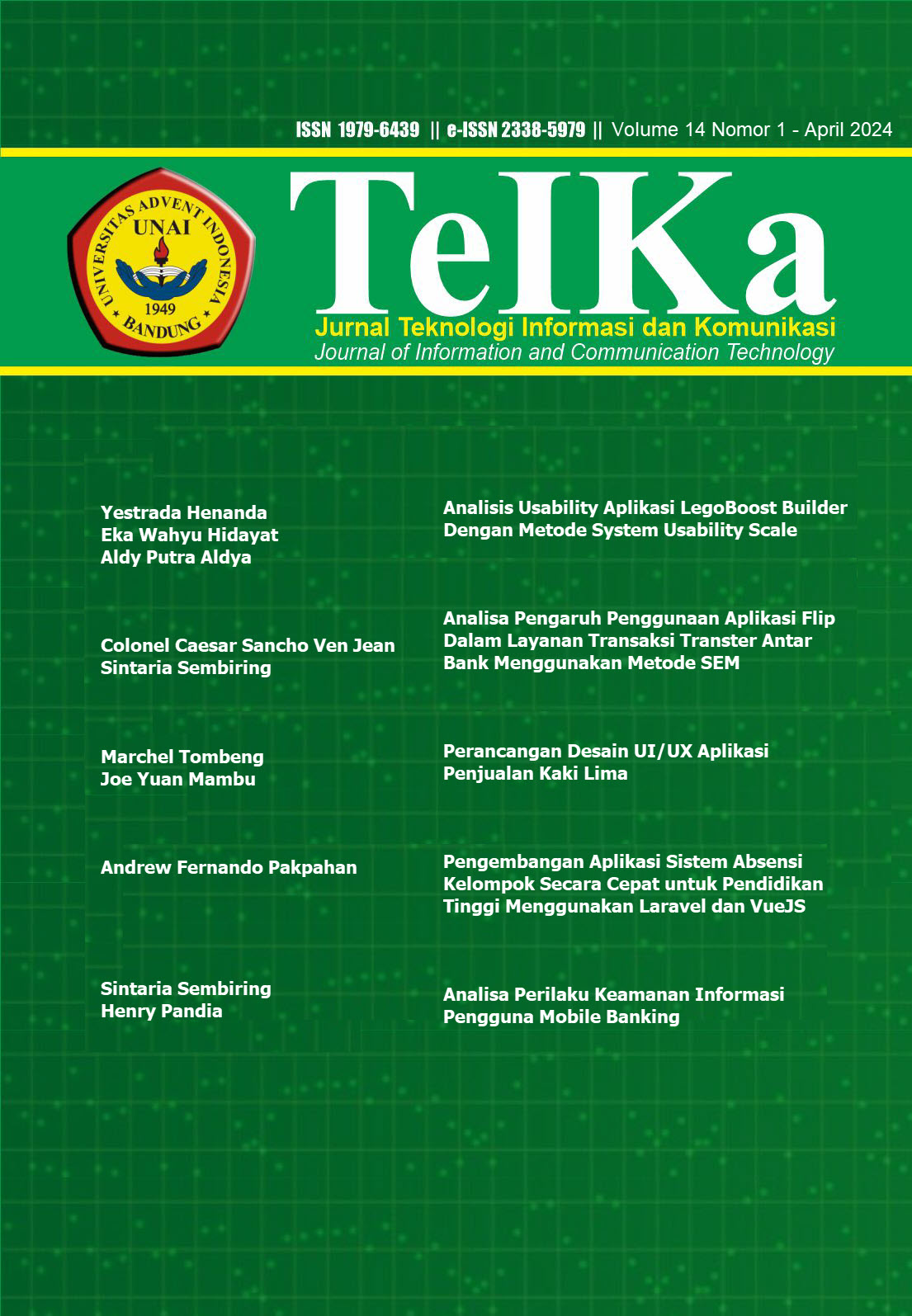UI/UX Design of Street Vendor Sales Application
Keywords:
figma, design thinking, ui and ux, applicationAbstract
In today's rapidly evolving digital landscape, mobile applications have become integral to everyday life, transforming interactions across various services, including food procurement. Despite the growing popularity of online food sales, challenges persist in ensuring accessibility and user satisfaction, particularly with traditional dishes like "bakso tusuk." This research aims to address these challenges by prioritizing intuitive user interface design and enhancing user experience within a specialized food sales application for bakso tusuk. Through the effective integration of UI/UX design elements, the goal is to deliver a seamless and enjoyable online shopping experience for users, thereby fostering trust and bolstering business growth within the digital sphere. Employing the Design Thinking methodology, the study progresses through empathizing with users, defining problems, generating ideas, prototyping solutions, and testing outcomes, ultimately striving to produce a user-centric application that positively impacts the online culinary industry and enhances consumer convenience in digital food purchasing. Recommendations include broader engagement with respondents for empathy-driven problem-solving and future updates tailored for web-based platforms, ensuring ongoing enhancement and competitiveness in the dynamic market.
Downloads
References
Z. Nuryana, “Pemanfaatan Teknologi Informasi Dalam Pendidikan Agama Islam,” Tamaddun, vol. 19, no. 1, hlm. 75, Mar 2019, doi: 10.30587/tamaddun.v0i0.818.
F. Nurcahyono, “Pembangunan Aplikasi Penjualan Dan Stok Barang Pada Toko Nuansa Elektronik Pacitan,” vol. 4, no. 3, hlm. 5, 2012.
C. M. Chandra, C. M. Putri, D. R. Theja, S. N. Hakim, dan M. R. Pribadi, “Perancangan UI/UX Pada Aplikasi Femine Menggunakan Metode Design Thinking,” hlm. 7, 2021.
R. F. A. Aziza dan Y. T. Hidayat, “Analisa Usability Desain User Interface Pada Website Tokopedia Menggunakan Metode Heuristics Evaluation,” . ISSN, vol. 13, no. 1, hlm. 5, 2019.
Y. M. Geasela, P. Ranting, dan J. F. Andry, “Analisis User Interface terhadap Website Berbasis E-Learning dengan Metode Heuristic Evaluation,” hlm. 8.
F. Fariyanto dan F. Ulum, “Perancangan Aplikasi Pemilihan Kepala Desa Dengan Metode Ux Design Thinking (Studi Kasus: Kampung Kuripan),” J. Teknol. Dan Sist. Inf., vol. 2, no. 2, hlm. 9.
J. Siwalankerto, “Bryan Wiguna1, Daniel Kurniawan2,” hlm. 9.
S. S. Rosyda dan I. Sukoco, “Model Design Thinking pada Perancangan Aplikasi Matengin Aja,” Organum J. Saintifik Manaj. Dan Akunt., vol. 3, no. 1, hlm. 1–12, Jul 2020, doi: 10.35138/organum.v3i1.69.
A. A. Razi dan I. R. Mutiaz, “Penerapan Metode Design Thinking Pada Model Perancangan Ui/Ux Aplikasi Penanganan Laporan Kehilangan Dan Temuan Barang Tercecer,” vol. 3, no. 2, hlm. 19, 2018.
R. Sugangga, “Pengembangan Produk Menggunakan Design Thinking Pada Masa Pandemi Covid-19,” vol. 18, no. 2, hlm. 5, 2020.
Rully Pramudita, Rita Wahyuni Arifin, Ari Nurul Alfian, Nadya Safitri, dan Shilka Dina Anwariya, “Penggunaan Aplikasi Figma Dalam Membangun Ui/Ux Yang Interaktif Pada Program Studi Teknik Informatika Stmik Tasikmalaya,” J. BUANA Pengabdi., vol. 3, no. 1, hlm. 149–154, Jul 2021, doi: 10.36805/jurnalbuanapengabdian.v3i1.1542.
“MDP Student Conference (MSC) 2022,” hlm. 8, 2022.
D. Oleh, “Desain Interaksi Aplikasi Platform Traveler Menggunakan Pendekatan Design Thinking,” hlm. 82.
K. Angelina, E. Sutomo, dan V. Nurcahyawati, “10. Desain UI UX Aplikasi Penjualan dengan Menyelaraskan Kebutuhan Bisnis menggunakan Pendekatan Design Thinking 7078,” vol. 9, hlm. 9, 2022.
D. Oleh, “Perancangan Ulang Ui/Ux Situs E-Learning Amikom Center Dengan Metode Design Thinking (Studi Kasus: Amikom Center),” hlm. 80.
Downloads
Published
How to Cite
Issue
Section
License
Copyright (c) 2024 TeIKa

This work is licensed under a Creative Commons Attribution-ShareAlike 4.0 International License.
The submitting author warrants that the submission is original and that she/he is the author of the submission together with the named co-authors; to the extend the submission incorporates text passages, figures, data or other material from the work of others, the submitting author has obtained any necessary permission.
Articles in this journal are published under the Creative Commons Share Alike Attribution Licence (CC-BY-SA What does this mean?). This is to get more legal certainty about what readers can do with published articles, and thus a wider dissemination and archiving, which in turn makes publishing with this journal more valuable for you, the authors.
By submitting an article the author grants to this journal the non-exclusive right to publish it. The author retains the copyright and the publishing rights for his article without any restrictions.










